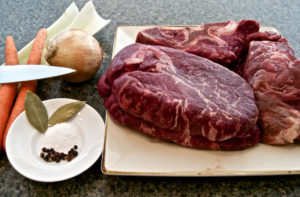Selecting and Serving Produce Safely
Eating contaminated produce can lead to foodborne illness, often called “food poisoning.” So as you enjoy fresh produce, follow these safe handling tips to help protect you and your family.

Fruits and vegetables are an important part of a healthy diet.
As you enjoy fresh produce, follow these safe handling tips to help protect yourself and your family.
Fruits and vegetables are an important part of a healthy diet. Your local markets carry a wide variety of nutritious fresh fruits and vegetables. However, harmful bacteria that may be in the soil or water where produce grows can come in contact with fruits and vegetables and contaminate them. Fresh produce may also become contaminated after it is harvested, such as during storage or preparation.
Eating contaminated produce can lead to foodborne illness, often called “food poisoning.” So as you enjoy fresh produce, follow these safe handling tips to help protect you and your family.
Buy Right
You can help keep produce safe by making wise buying decisions.
- Choose produce that is not bruised or damaged.
- When buying pre-cut, bagged or packaged produce — such as half of a watermelon or bagged salad greens — choose only those items that are refrigerated or surrounded by ice.
- Bag fresh fruits and vegetables separately from raw meat, poultry, and seafood when packing them to take home from the market
Store Properly
Proper storage of fresh produce can affect both quality and safety.
- Store perishable fresh fruits and vegetables (like strawberries, lettuce, herbs, and mushrooms) in a clean refrigerator at a temperature of 40° F or below. Use a refrigerator thermometer to check! If you’re not sure whether an item should be refrigerated to keep its quality, ask your grocer.
- Refrigerate all produce that is purchased pre-cut or packaged .
Separate for Safety
Keep fruits and vegetables that will be eaten raw separate from raw meat, poultry, and seafood — and from kitchen utensils used for those products.
- Wash cutting boards, dishes, utensils, and countertops with soap and hot water between preparing raw meat, poultry, and seafood and preparing produce that will not be cooked.
- If possible, use one cutting board for fresh produce and a separate one for raw meat, poultry, and seafood.
- If you use plastic or other non-porous cutting boards, run them through the dishwasher after use
Prepare Safely
When preparing any fresh produce, begin with clean hands. Wash your hands for at least 20 seconds with soap and warm water before and after preparation.
- Cut away any damaged or bruised areas on fresh fruits and vegetables before preparing and/or eating. Throw away any produce that looks rotten.
- Wash all produce thoroughly under running water before preparing and/or eating, including produce grown at home or bought from a grocery store or farmers’ market. Washing fruits and vegetables with soap, detergent, or commercial produce wash is not recommended.
- Even if you do not plan to eat the skin, it is still important to wash produce first so dirt and bacteria are not transferred from the surface when peeling or cutting produce.
- Scrub firm produce, such as melons and cucumbers, with a clean produce brush.
- After washing, dry produce with a clean cloth towel or paper towel to further reduce bacteria that may be present on the surface
What About Pre-Washed Produce?
Many pre-cut, bagged, or packaged produce items are pre-washed and ready-to-eat. If so, it will be stated on the packaging, and you can use the produce without further washing.
If you choose to wash produce marked as “pre-washed” or “ready-to-eat,” be sure that it does not come in contact with unclean surfaces or utensils. This will help to avoid cross contamination.
About Foodborne Illness
Know the Symptoms
Consuming dangerous foodborne bacteria will usually cause illness within 1 to 3 days of eating the contaminated food. However, sickness can also occur within 20 minutes or up to 6 weeks later. Although most people will recover from a foodborne illness within a short period of time, some can develop chronic, severe, or even life-threatening health problems.
Foodborne illness can sometimes be confused with other illnesses that have similar symptoms. The symptoms of foodborne illness can include:
- Vomiting, diarrhea, and abdominal pain
- Flu-like symptoms, such as fever, headache, and body ache
Take Action
If you think that you or a family member has a foodborne illness, contact your healthcare provider immediately. Also, report the suspected foodborne illness.
Sprouts: What You Should Know
Like any fresh produce that is consumed raw or lightly cooked, sprouts that are served on salads, wraps, sandwiches, and in some Asian food may contain bacteria that can cause foodborne illness. But unlike other fresh produce, sprouts are grown from seeds and beans under warm and humid conditions. These conditions are also ideal for the growth of bacteria, including Salmonella, Listeria, and E. coli. If just a few harmful bacteria are present in or on the seed, the bacteria can grow to high levels during sprouting, even if you are growing your own sprouts under sanitary conditions at home.
Children, older adults, pregnant women, and people with weakened immune systems (such as transplant patients and individuals with HIV/AIDS, cancer, and diabetes) should avoid eating raw or lightly cooked sprouts of any kind (including onion, alfalfa, clover, radish, and mung bean sprouts). When eating out, you can ask that raw sprouts not be added to your food. If you purchase a sandwich or salad at a restaurant or delicatessen, check to make sure that raw sprouts have not been added.
What can consumers do to reduce the risk of illness if they want to eat sprouts?
- Wash sprouts thoroughly under running water before eating or cooking. Washing may reduce bacteria that may be present, but it will not eliminate it.
- Cook sprouts thoroughly. Cooking kills harmful bacteria and reduces the risk of illness.











